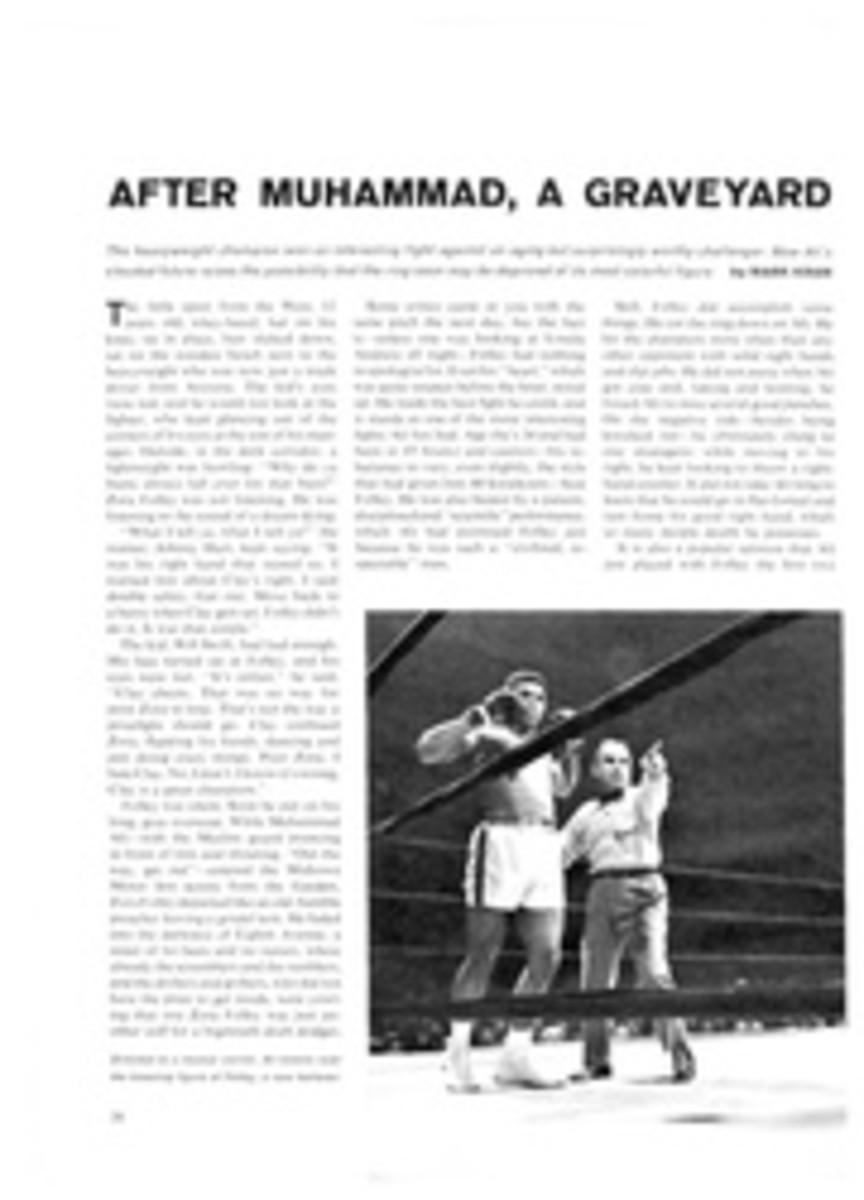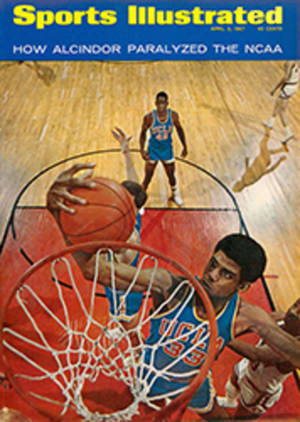
Roll Out a Barrel and Some Daredevil Will Jump It
Jompeeng the barrel is beeg plezzure," says a beeg Montrealer named Gilles LeClerc, as he lets his hand follow the trajectory of a skater soaring over scores of obstacles. LeClerc should know. Though he came late to the sport, he is one of Canada's finest jumpers. But not everyone shares his enthusiasm. Despite its obvious challenge to nerve and skill, barrel jumping has been pursued, for the most part, in wintry obscurity. Even surefire gimmicks dreamed up by flacks at barrel-jumping contests to promote the sport have somehow misfired. Once Yogi Berra was persuaded to hand out a trophy at a barrel-jumping championship, and the newsmen present were so entranced with Yogi that they forgot to interview the barrel jumpers. Another competition failed to get proper recognition in the newsreels, because all the cameras present were focused on a bosomy blonde who insisted on leaning far over the fence during most of the jumping.
In this day of the tennis bum, the golf millionaire, the bonus baby and the $400,000 quarterback, barrel jumpers have only the "beeg plezzure" to sustain them. Yet a surprising number find it enough—and a surprising number of fans turn up to watch them. In recent years officials of the Montreal Forum, home ice of the famed Canadiens' hockey team, have permitted barrel jumpers to work out on the ice when the hockey games are over, but they firmly insist that no one must jump until the last hockey fan has left. One time the jumping started before the arena was cleared, and the police had to be summoned to control the 5,000 fascinated fans pushing their way forward to see better.
Barrel jumping is believed to have begun in Holland some 300 years ago, although there is no record of how many barrels Hans Brinker cleared. In those days skaters did not jump over barrels, but over mounds of snow. Later they vaulted over beer kegs. Modern-day jumpers use fiber-composition barrels 16 inches in diameter and leap over as many as 17 laid side by side.
More than anyone else, perhaps, an enthusiast named Irving Jaffee is responsible for formalizing the sport. Jaffee conjured up the idea of a title match in 1951, when he found that every trick skater he knew was calling himself the world champion barrel jumper. To settle the issue, he invited jumpers from all over the world to Grossinger's in the Catskills for a showdown. At first it seemed as if no one would show up: Jaffee went to his office in Manhattan and waited and waited. Then "at 3 or 4 in the morning on the day of the meet some Canadians finally arrived," he says. "I felt as though I had been born again. Then Terry Browne, a fireman from Detroit and an Olympic speed skater, showed up. At least we had enough jumpers for a meet. Browne won that first meet and the next three, as well."
Most barrel jumpers are speed skaters or hockey players. Professionally, they have been lawyers, opticians, bookkeepers and policemen. One was a prominent stock-car driver, another a hair stylist for Lilly Daché. All are daredevils.
"I won two Olympic gold medals as a speed skater [both in 1932], and I've played some hockey," says Jaffee, "but I'd never have the guts to try barrel jumping. It requires a lot of courage. Why, some of those boys are going 50 miles an hour when they're over the barrels. Once we tried to lengthen the landing space so the jumpers wouldn't crash so hard. They refused to allow it. They wanted less landing room so they could have more space to skate and build up speed for their jumps. We make them wear plastic helmets, gloves and pads to protect their backs, but these guys are wild men."
Barney Ross, the late boxing champion, once said, "I'd rather take 15 rounds of punishment in the ring than do what those barrel jumpers do."
Now another season of barrel jumping is over, and it may still be that the fans who make the golfers and the baseballers rich couldn't care less. But the barrel jumpers care, and now that they're all back at their humdrum jobs they'll spend a summer talking about the season past and the most recent championships held, as always, at Grossinger's.
Fireman Terry Browne, now 45 but as spry as ever, was there as usual. So was Richard Widmark, not the actor but an Illinois contractor who played quarterback for Northwestern a while back. Three Canadian deaf mutes were on hand, and from Northbrook, Ill. came Chuck Burke, a pipe fitter. Keith Meyer, a mechanical engineer, came from Oak Park, Ill. Roger Wood, a 17-year-old high schooler from Portland, Ore., was the youngest ever to compete for the title. And, of course, there was LeClerc, now the manager of a supermarket.
Back also to try to regain his old championship was Ken LeBel of Great Neck, N. Y. Ken's three-year reign as champion had ended a year before, when Jacques Favero became the first Canadian to win the event. "It's not that I want to beat the Canadian so much as it is that I want to prove that I'm still the best jumper," said LeBel, who is 28 years old and somewhat battered. A year before he had a bad crash landing and gashed his knee so severely that it required three layers of stitches to put him back together.
Jacques St. Pierre, another bruised and battered jumper, was lucky to be alive, let alone at Grossinger's. Four years before he had been practicing for a bicycle race when he was struck by a car doing 75 mph. He sustained two perforated lungs, a fractured skull and several broken ribs. He left the hospital after three months with a silver plate in his left leg.
"Nobody said it, but everybody thought that all sport was finished for me," St. Pierre recalled. But in the next few years to prove them wrong, he became, in turn, a champion swimmer, a gymnast, a skater and a barrel jumper. "After practicing at the pool for a swimming championship, I used to go out back and watch the jumpers," St. Pierre says. "I thought it was a funny sport. But one day they say to me, 'You have laughed enough. Now you try it.' Three days later I won the junior provincial championship by clearing 12 barrels."
The day of the championship was clear and crisp. There was more than enough color to please even the ABC-TV officials, who had flown in two specialists from Hollywood to get just the right tint of blue in the ice for their colorcast.
Jumpers huddled in pink, blue, yellow, green and brown blankets on sideline benches. Favero was outfitted in a striking red uniform, LeBel in black, others in purple, blue and enough assorted colors to make a rainbow look pale.
Once the competition began the jumpers clattered into barrels, landed with thuds and slammed into a Matterhorn of mattresses designed to soften their quick stops. Some skaters did belly whoppers at 30 and 40 mph, one crashing head-first into the row of barrels. They tumbled wildly, gasped for breath after the wind had been knocked out of them and then wiggle-wobbled back to the bench to await their next turn.
One by one the contestants were eliminated, until only LeBel, St. Pierre—who had gone to bed at 10 the night before and had lain awake worrying until 3 a.m.—and Widmark were left. Widmark, in his three tries at 16, went clunk, splat and whomp, and tottered away as if he had been creamed by a linebacker.
Now it was LeBel against St. Pierre. The yellow 17th barrel was set in line. If neither cleared that barrel, the victory would go to St. Pierre, who had leaped 28 feet 3¼ inches. LeBel's longest jump was 27 feet, and he had torn a stomach muscle in the process. St. Pierre failed in three tries at 17 barrels, and now it came down to one last jump for LeBel.
Slowly LeBel skated around the blue-tinted ice. He stopped to stare at the long row of barrels, then skated away, churning up more and more speed with each stride as he circled the rink once, then twice. He flashed around the final curve, angled toward the barrels, then pumped his arms for the lift-off. He rose and flew—over all the barrels but one. LeBel thudded to the ice, a black streak skidding and skittering out of control, until he came to an inglorious rest against the barricade of mattresses.
St. Pierre turned down the winner's purse because he wanted to retain his amateur status. He accepted a trophy instead and a kiss from French Actress Francoise Hardy. After all, as Gilles LeClerc said, the beeg plezzure is the jompeeng.

